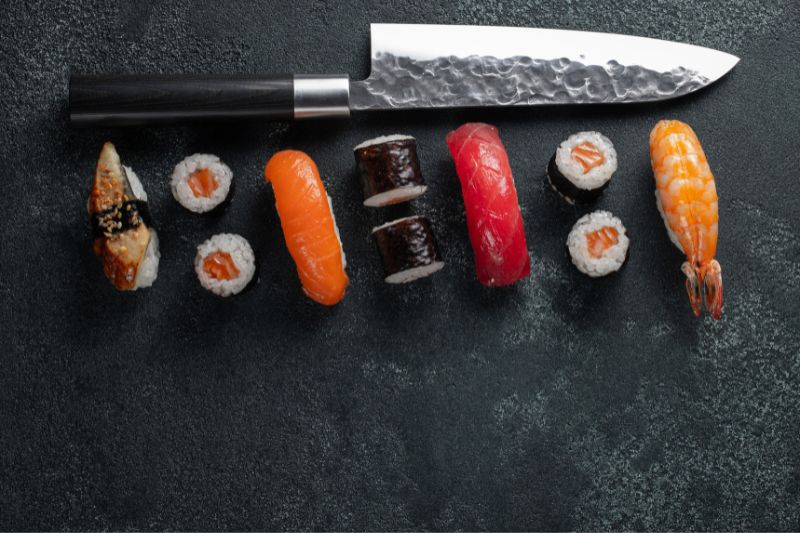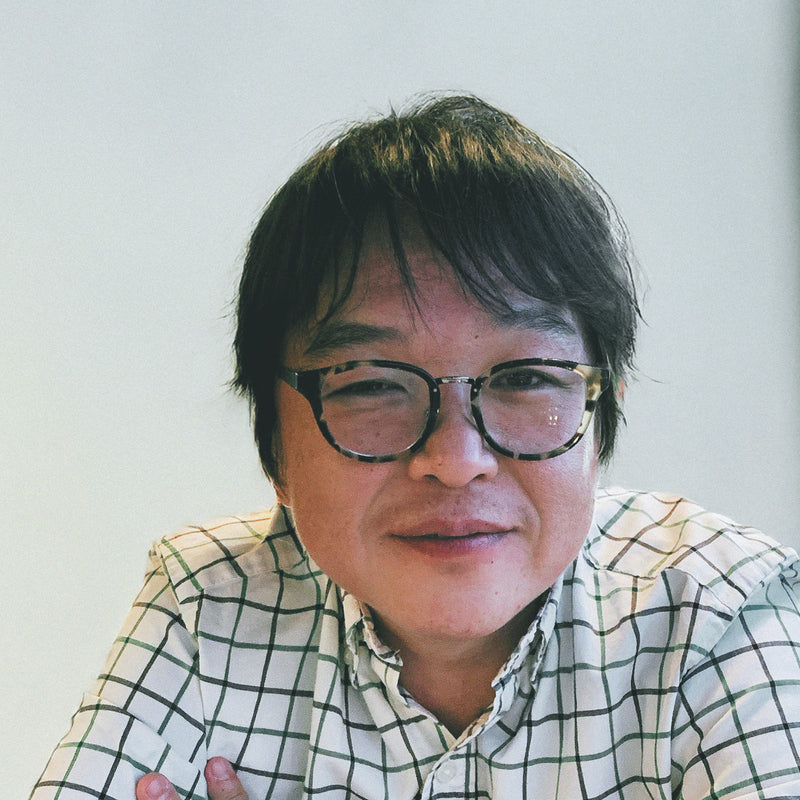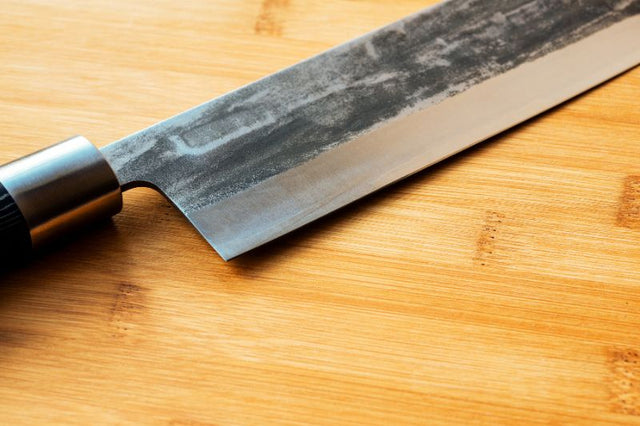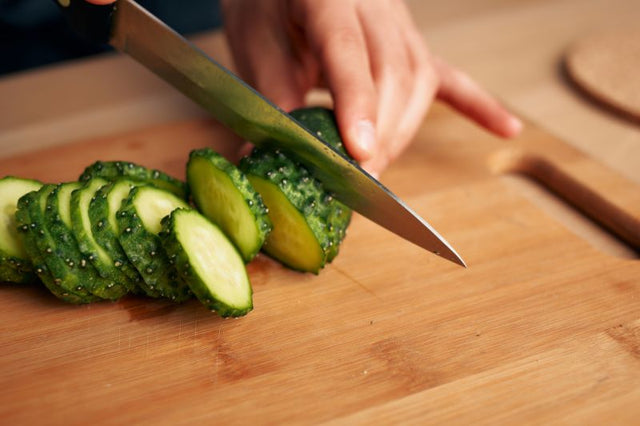“A noble-looking man sits with a large wooden board in front of him on which lies a large fish. He is adorned in traditional Japanese clothing - a sleek, long hat and wide-sleeved kimono outfit that commands respect and reflects centuries of history. He has a razor-sharp sword-like knife in his left hand and a pair of unusually long steel chopsticks in his right hand.
He starts slicing through the raw fish with swift, precise movements, using only the knife and the chopsticks, without a single part of his hands ever touching the fish. There is not a single sound in the room except for the sound of steel dancing through the fish. The knife master’s focus is laser sharp, his knife-handling skills magnificent, and the aura around him formidable.
Finally, he lays the impeccably portioned fish on the wooden board as if he is presenting his offerings to a divine being.”
The above description might sound like a scene from a Samurai movie, but this is how I would describe a Houchou-shiki or a Japanese knife ceremony.
Most of us have heard about traditional Japanese ceremonies such as tea ceremonies, flower arrangement ceremonies, cherry blossom ceremonies, and so on. I explained the Japanese tea ceremony in 6 simple steps, read it here. Through these ceremonies, we celebrate the beautiful Japanese traditions and culture. However, have you heard of another Japanese ceremony called “Houchoushiki”? Even though it is a fascinating Japanese ceremony that is representative of many essential aspects of Japanese culture, history, and philosophy, not many people have heard about it, and it is indeed rare to come by, even in Japan these days. Therefore, today, I would love to tell you about this unique Japanese ceremony - its origin, its hidden meaning, and why it is such an important part of Japanese culture and history.

What is Houchoushiki - a Simple Definition
Like the other Japanese ceremonies, it isn't easy to define the Houchoushiki in simple terms. However, the most straightforward answer would be that it is a traditional Japanese ceremony consisting of different rituals handed down from ancient times in Japan, and it is always performed by a "Houchou-Shi (a knife-master)." The Houchou-shi holds a pair of ceremonial chopsticks in his left hand and a ceremonial knife in his right. Then using the chopsticks and the knife, he cuts the food ingredients (meats, fish, bird, etc.) in a specific manner, ensuring that his hands are never in direct contact with the food ingredients.

The Origin of Houchoushiki - Notable Figures Behind the Origin of Houchoushiki and How They Popularized it
It is said that the most primitive forms of the Houchoushiki ceremony existed in Ancient Japan, but to be a bit more specific, the earliest record of this ceremony is found during the Heian period (the last division of classical Japanese history, running from 794 to 1185), around 860. Interested in knowing more about the history of Japanese knives? Hop onto this article.
Records and mention of ‘Houchoushiki’ can be found in important Japanese literature such as:
- Nihon-Shoki (日本書記) : The second oldest book of classical Japanese history, often titled as ‘the chronicles of Japan’ in English
- Shiki-Hou-Hisho (式法秘書) : Roughly translated to “Correct rituals and Etiquettes from the collections of the imperial courts”. It is an archive from the Meiji era (Meiji 34).
- Encyclopedia of Japanese Cuisine (日本料理法大全):A comprehensive encylodpedia on the art of Japanese cuisine, first published in Meiji 31.
According to literature, the Houchoushiki is a ceremony with more than 1140 years of history. It is also found that there were three main historical figures (one of them is mythological and worshiped as a divine being) who contributed greatly to the development of the Houchoushiki ceremony:
- Iwaka Mustsukari no Mikoto ( 磐鹿六雁命):
Iwaka Mutsukari no Mikoto is an interesting figure in the Japanese history of Houchou-shiki because he was a royal ancestor who later attained the position of being a divine being and hence started to be worshiped as ‘the God of cooking’.
According to Nihon-Shikisho, Japan was ruled by Emperor Keikō from 71 - 130 AD. Emperor Keiko had a son who also led many expeditions, but the son passed away, causing great sadness to the Emperor. To commemorate his son, the Emperor made a tour of the places special to him. During this trip, which took place during the year 711, ‘Iwaka Mutsukari no Mikoto’ was a courtier for Emperor Keiko. A courtier is a person who attends the royal court as an advisor or a companion, like a personal assistant in modern times.
When they arrived at a shrine called Ukishima no Miya (Awa Province, Tokushima prefecture of current times), Iwaka Mutsukari no Mikoto caught white clam shells and tuna fish and turned them into beautiful grilled dishes, stewed dishes, and Namasu (a Japanese dish made with raw vegetables and fish, seasoned with vinegar), and presented them in leaves of goby tree and Japanese umbrella pine.
The Emperor was deeply moved and highly impressed by Iwaka Mutsukari no Mikoto’s cooking and cutting skills. He granted him the title “膳大伴部(かしわでのおおともべ)Kashi-wade-no-Ootomobe” (roughly translating to the person in charge of the vocational department in charge of the meals for the royal court).
After serving as the head of the imperial kitchen for years, Iwaka Mutsukari no Mikoto passed away in the year 720. Emperor Seimu felt a huge loss, as he was as impressed by Iwaka’s cooking skills as the previous Emperor was. Therefore, to honor Iwaka and his art of cooking, Emperor Seimu assigned the role of cooking for the imperial court to Iwaka’s children and grandchildren.
From that point, the descendants of Iwaka Mutsukari no Mikoto (the Takahashi clan) inherited and served the post of Daizenshiki (Office of the Palace Table) at court for generations.
At the Daizenshiki (Office of the Imperial Kitchen), there was a department called the Shoin, which was responsible for brewing soy sauce. Iwaka Mutuskari no Mikoto was worshiped in this department as ‘Takabe no Kami (The God of brewing and seasoning).”
In modern times, Iwaka Mutuskari no Mikoto is considered the ‘god of cooking, brewing, and seasoning” and is worshiped by many Japanese people working or doing business in the food and culinary industry. He is enshrined in temples such as Takabe Shrine (Minami-Boso, Chiba prefecture) and Takahashi Shrine (Tochigi prefecture).

Takabe Shrine, where Iwaka is the central being of worship, is one of the very few places in Japan where one can experience the Houchou-Shiki ceremony, even today.
Iwaka Mutsukari no Mikoto was a major figure in the development of the Houchou-Shiki ceremony because he was the origin of the kitchen and religion merging together. From the time Iwaka Mtsukari no Mikoto transformed from a kitchen master (chef and knife handler) to a divine being, kitchen utensils, cooking, and food ingredients started appearing as parts of rituals in the Shinto belief system.
- Fujiwara no Yamakage ( 824 - 888 ):
Fujiwara no Yamakage, a descendant of the Fujiwara clan, was an influential nobleman who lived during the Heian period (794 to 1185). He served many different roles in the Imperial Court over many years under different emperors. Some notable positions held by Fujiwara no Yamakage are vice-councilor of state, Minister of Popular Affairs, Senior Secretary of the Left Division of Bureau of Horses, Chamberlain, Head Chamberlain, Royal Advisor, chief official of the retired emperor's office, etc.
Fujiwara no Yamakage has been called by the aristocrats of his time by the names "the father of Hochodo (the art of using Japanese knives)" and the "god of cooking." Even today, he is known as the founder of the Shijo School of Houchoudo. Before Fujiwara, no Yamakage established the Shijo school of cooking and Houchoudo, the cooking traditions and the rules of Houchoushiki were managed by the Takahashi clan (Iwakamutsukari no Mikoto's descendants). However, Fujiwara no Yamakage introduced new methods of cooking and new rules for the Houchoushiki.
In Ibaraki city of Osaka prefecture, there is a temple called Soji-ji, built by Fujiwara no Yamakage. Every year on April 18th, a Yamakage-ryu Houchoushiki ceremony is held even today in this temple.
- Emperor Kōkō (830 – 887)
Emperor Koko was the 58th emperor of Japan, and he was renowned for his love for food and cooking. Traditionally, emperors and royal members in Japan did not get involved in doing daily household work such as cooking. However, Emperor Koko would hold and use knives himself which was quite unusual for an emperor during those times. He also incorporated Houchoushiki ceremony into many royal court ceremonies, which helped the popularity of the knife ceremony to spread among noble families.
Under Emperor Koko, Fujiwara no Yamakage established the Shijo School of Cooking. It was a significant step in the history of Japanese knives and cooking methods because the ways and approaches of the Shijo school were quite different from the traditional methods used before by the Takahashi clan.
The Official Establishment of Houchou-Shiki Ceremony
According to ‘Shiki Hou Hisho (an archive from the imperial courts on ritual and etiquettes in ancient Japan),’ the first record of a proper ‘Houchou shiki’ is from 859. The Emperor at the time was Emperor Koko, the 58th emperor of Japan.
In the year 859, Fujiwara no Yamakage started working on forming the theory and guide for the rituals and rules for the Shijo school’s Houchoushiki ceremony. Twenty-seven years later, in 886, Emperor Koko, who was well-known for his love of cooking, actively incorporated the Houchou-Shiki knife ceremony as an essential part of the imperial court ceremonies. He himself hosted a knife ceremony where he used a cooking knife to demonstrate the Houchoushiki ceremony.
In 711, the Takahashi clan (descendants of Iwaka Mistukari no Mikoto), who at that time was the officially established clan for cooking and knife-related traditions, received training from Fujiwara no Yamakage on the Shijo-school style of Houchoushiki ceremony and started practicing the Houchousiki ceremony in Shijo-school style.

About Houchou-Shi (The Knife-Master)
When discussing Houchou-shiki (knife ceremony), we cannot skip looking at Houchou-shi (the knife master). He is the person who 'hosts' the ceremony, and he is the central performer. So it is helpful to know about who 'a knife master' is, the responsibility and significance this title holds, and his roles in the traditional Japanese kitchen.
In traditional Japanese cooking schools, once a 'school (Ryuuha)’ or 'discipline' (e.g., Shijo school) is formed, new pupils or disciples start joining the kitchen. Once a number of disciples start working in the kitchen under a "Houchou-Shi" (a knife master or something similar to a modern-day 'head chef'), this group was called a "Houchou-ka" (庖丁家), which means "Cooking knife family." The Houchou-shi is the head of a Houchou-ka, and he is the one who is the expert on cooking techniques, seasonings, and extraction methods and knows the most about how to use and maintain knives and other cooking equipment. He is also the one who makes sure that all the rules and rituals of the Houchou-shi ceremony are followed properly. Therefore, the Houchou-shi or a knife-master's position is one that is regarded highly, and they are the ones who could cook for the nobles such as imperial court members and notable samurais.
Below is an example to show the workflow and responsibilities of a Houchou-shi during an imperial court ceremony. I think this is a good example because it also shows an instance where Houchou-Shiki was performed in the royal court.
A Houchou-shi's Core Roles and Responsibilities During a Genpuku Ceremony.
(Genpuku ceremony is a coming-of-age ceremony that dates back to the Nara period. Through this ceremony, a royal family member's transition from childhood to adulthood was celebrated.)
- Plan a menu appropriate for the Genpuku ceremony (select ingredients and dishes)
- Stock up on the ingredients.
- Clean and prepare the ingredients according to the rules of Houchoushiki
- Supervise the apprentice chefs while they do the cooking.
- Serve the food to the guests at the ceremony while wearing formal clothing appropriate for the Genpuku ceremony.
- Check and observe the dishes' composition and presentation while being served to the guests at the ceremony.
- Perform the Houchoushiki ceremony in front of the guests and then enter the banquet of the ceremony.

Fig: National Diet Library of Japan, From the book Jinrin-Kunmo zui published 1690
Diving into the Details of the Houchou-Shiki Ceremony
The rules and rituals of the Houchoushiki ceremony have been passed down many generations, from the kitchen knife master (Houchou-shi) to the kitchen knife family (Houchou-ka) and the cooking school (Ryuuha). With the passing of time, little details of it might have changed, and there are some differences among the different schools. However, the basic principles and rules are very similar. Let’s closely examine what a proper Japanese knife ceremony looks like.
Ingredients used in Houchou-shiki ceremony
- Birds: Cranes and swans
- Fish: Carp and Sea bream

Figure: Pictures depicting how the fish or bird for the ceremony should be cut (Source: Encyclopedia of Japanese Cooking Methods)
Tools and Costumes used during Houchoushiki ceremony
Tools:
- Houchou (Japanese Kitchen Knife)
- Large Japanese cutting Board (Made of wood)
- Chopsticks
Figure : Tools for Houchoushiki (Source: Japanese Encyclopedia of Cooking Methods)
Costume:
- Hitatare: It is a traditional form of kimono with a large square-cut coat and cord-laced sleeves. It was considered as the formal robe for samurais worn especially at the imperial courts.
- Kariginu: Kariginu was the casual wear for Shinto-priests. This type of kimono was also used during hunting by aristocrats.
Etiquettes of Houchoushiki
During the Houchoushiki ceremony, there are certain etiquettes that the Knife-master has to follow. For example, the knife master has to use a single knife to cut a fish into three pieces, debone the fish, and slice the pieces into sashimi. There are also specific rules for how to clean the knife between the movements and how to dry the knife. As the hands of the knife master never touch the food ingredients, it is also quite hygienic.
Mizunade, Kakari, and How Houchoushiki was Used to Metaphorically Purify Food Ingredients
According to the concept of the Houchoushiki ceremony, the ingredients used for the ceremony, such as birds and fish, used to be living creatures before they were hunted for the ceremony. This meant that when they were placed on the "Mana-ita," the chopping board, they were mere carcasses of the creatures and hence 'impure'. To serve this to royal members of the imperial court as the food was considered to be barbaric. Hence, Houchoushiki served as a method to metaphorically purify the food ingredients and make them worthy of being served to the noble aristocrats.
Mizunade and Kakari are two such rituals of the Houchoushiki ceremony that 'purifies' the food ingredients.
- Kakari (懸り): In the Houchoushiki ceremony, the ritual for purifying the corpses of food ingredients is called Kakari. A knife master had to perform this ritual at the very beginning of the ceremony; otherwise, the food ingredients were considered to be impure and inappropriate to be served to the guests.
- Mizunade (水撫): Mizunade literally translates to 'Water strokes', a concept that describes the knife's motion during the Houchoushiki ceremony. The way the knife slices through, cuts, and lifts the food ingredients should be so swift, graceful, and smooth that it is like the knife is 'caressing water.'
Where to See the Houchoushiki Ceremony First-Hand in Japan
Although the Houchou-Shiki ceremony is an important part of the tradition of Japanese cuisine, it is rarely seen these days in Japan. There are only a very few places in Japan where it is performed for the general public. If you do get a chance to visit one, I would highly recommend it, as it is such a rich depiction of the heart and soul of the art of Japanese cooking and knife usage.
- Takabe Shrine
Takabe shrine is a Shinto shrine dedicated to the 'God of Cooking.' Around the year, Takabe shrine hosts several Houchou-shiki ceremonies open to the public.
Address: 164 Chikuracho Minamiasai, Minamiboso, Chiba 295-0012, Japan
- Sojiji Temple
Built by Fujiwara no Yamakage, the legendary founder of Shijo school, this temple in Osaka prefecture is famous for its Yamakge-school style Houchoushiki ceremony that is held every year on April 18th.
 Takabe Shrine Minami-Boso, Chiba prefecture
Takabe Shrine Minami-Boso, Chiba prefecture
Address: 1 Chome-6-1 Sojiji, Ibaraki, Osaka 567-0801, Japan
Final Words
The Houchou-Shiki ceremony is an excellent representation of the richness of the culture of the Japanese art of knives and the significance of knife masters in Japanese history. It is like a window through which people can glimpse years of practice, dedication, and hard work the knife masters put into perfecting their skills. If you would like to know more about the history of Japanese knives, head on to this article, and I hope you enjoy learning about Japanese knives as much as I do!
Get Free Bonus Books

Sign up for free to the Japanese Knife Club to get advice and exclusive articles about how to choose Japanese Knives, and tips and tricks for using Japanese knives.
About the author
Kei Nishida
Author, CEO Dream of Japan
Certification: PMP, BS in Computer Science
Education: Western Washington University
Kei Nishida is a passionate advocate of Japanese craftsmanship, a writer, and the founder and CEO of Japanese Knife Co., Japanese Green Tea Co., and Japanese Coffee Co., all part of Dream of Japan.
His journey began with a mission to introduce the world to the exquisite flavors of Japanese green tea. Through Japanese Green Tea Co., he pioneered the import of premium tea grown in nutrient-rich sugarcane soil, earning multiple Global Tea Champion awards. He then expanded into the world of coffee, launching Japanese Coffee Co., the first company to bring Sumiyaki charcoal-roasted coffee to a global audience.
With a deep appreciation for Japanese artistry and tradition, Kei turned his attention to one of Japan’s most revered crafts: bladesmithing. Through Japanese Knife Co., he made handcrafted katana-style knives, created by a renowned katana maker, available outside Japan for the first time. These exceptional knives embody centuries of samurai sword-making expertise, blending tradition with modern functionality for chefs and collectors alike.
Kei’s journey continues as he uncovers and shares Japan’s hidden treasures—one sip, one blade, and one legacy at a time.























